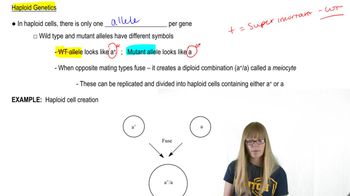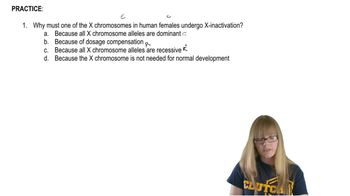A husband and wife have normal vision, although both of their fathers are red–green color-blind, an inherited X-linked recessive condition. What is the probability that their first child will be (a) a normal son, (b) a normal daughter, (c) a color-blind son, (d) a color-blind daughter?
Table of contents
- 1. Introduction to Genetics51m
- 2. Mendel's Laws of Inheritance3h 37m
- 3. Extensions to Mendelian Inheritance2h 41m
- 4. Genetic Mapping and Linkage2h 28m
- 5. Genetics of Bacteria and Viruses1h 21m
- 6. Chromosomal Variation1h 48m
- 7. DNA and Chromosome Structure56m
- 8. DNA Replication1h 10m
- 9. Mitosis and Meiosis1h 34m
- 10. Transcription1h 0m
- 11. Translation58m
- 12. Gene Regulation in Prokaryotes1h 19m
- 13. Gene Regulation in Eukaryotes44m
- 14. Genetic Control of Development44m
- 15. Genomes and Genomics1h 50m
- 16. Transposable Elements47m
- 17. Mutation, Repair, and Recombination1h 6m
- 18. Molecular Genetic Tools19m
- 19. Cancer Genetics29m
- 20. Quantitative Genetics1h 26m
- 21. Population Genetics50m
- 22. Evolutionary Genetics29m
2. Mendel's Laws of Inheritance
Sex-Linked Genes
Problem 24
Textbook Question
In humans, the ABO blood type is under the control of autosomal multiple alleles. Color blindness is a recessive X-linked trait. If two parents who are both type A and have normal vision produce a son who is color-blind and is type O, what is the probability that their next child will be a female who has normal vision and is type O?
 Verified step by step guidance
Verified step by step guidance1
Determine the genotypes of the parents for the ABO blood group. Since both parents are type A but have a child with type O, each parent must be heterozygous with genotype \(I^A i\) (where \(I^A\) is the allele for type A and \(i\) is the allele for type O).
Analyze the inheritance of the ABO blood group for the next child. Use a Punnett square to find the probability that the child will inherit the \(i\) allele from both parents, resulting in blood type O (\(ii\) genotype).
Determine the genotypes of the parents for the X-linked color blindness trait. Both parents have normal vision, but they have a color-blind son. Since color blindness is recessive and X-linked, the mother must be a carrier with genotype \(X^N X^c\) (where \(X^N\) is the normal allele and \(X^c\) is the color-blind allele), and the father must have normal vision with genotype \(X^N Y\).
Calculate the probability that the next child will be female and have normal vision. The child must inherit an \(X^N\) from the mother and an \(X^N\) from the father to have normal vision and be female (\(X^N X^N\)).
Combine the probabilities from the ABO blood group and the X-linked trait, and multiply by the probability that the child is female (which is 1/2), to find the overall probability that the next child will be a female with normal vision and blood type O.
 Verified video answer for a similar problem:
Verified video answer for a similar problem:This video solution was recommended by our tutors as helpful for the problem above
Video duration:
1mPlay a video:
Was this helpful?
Key Concepts
Here are the essential concepts you must grasp in order to answer the question correctly.
Multiple Alleles and ABO Blood Group Inheritance
The ABO blood group is determined by three alleles (IA, IB, and i) located on an autosome. IA and IB are codominant, while i is recessive. Blood type A can be genotype IAIA or IAi, and blood type O is ii. Understanding these allele interactions is essential to predict offspring blood types.
Recommended video:
Guided course

Haploid Genetics
X-linked Recessive Inheritance and Color Blindness
Color blindness is caused by a recessive allele on the X chromosome. Males (XY) express the trait if they inherit the affected X, while females (XX) must inherit two copies to be affected. Carrier females have one normal and one affected allele and show normal vision but can pass the trait to offspring.
Recommended video:
Guided course

Purpose of X Inactivation
Probability Calculation in Genetic Crosses
Calculating the probability of offspring traits involves combining independent probabilities of genotype and sex. This requires determining parental genotypes, using Punnett squares for autosomal and sex-linked traits, and multiplying probabilities for combined traits like blood type, vision, and sex.
Recommended video:
Guided course

Probability
Related Videos
Related Practice
Textbook Question
826
views


